Looking at Lunar Origins, the Waxing Moon Oversees Evening, and Morning Venus Kisses Mars!
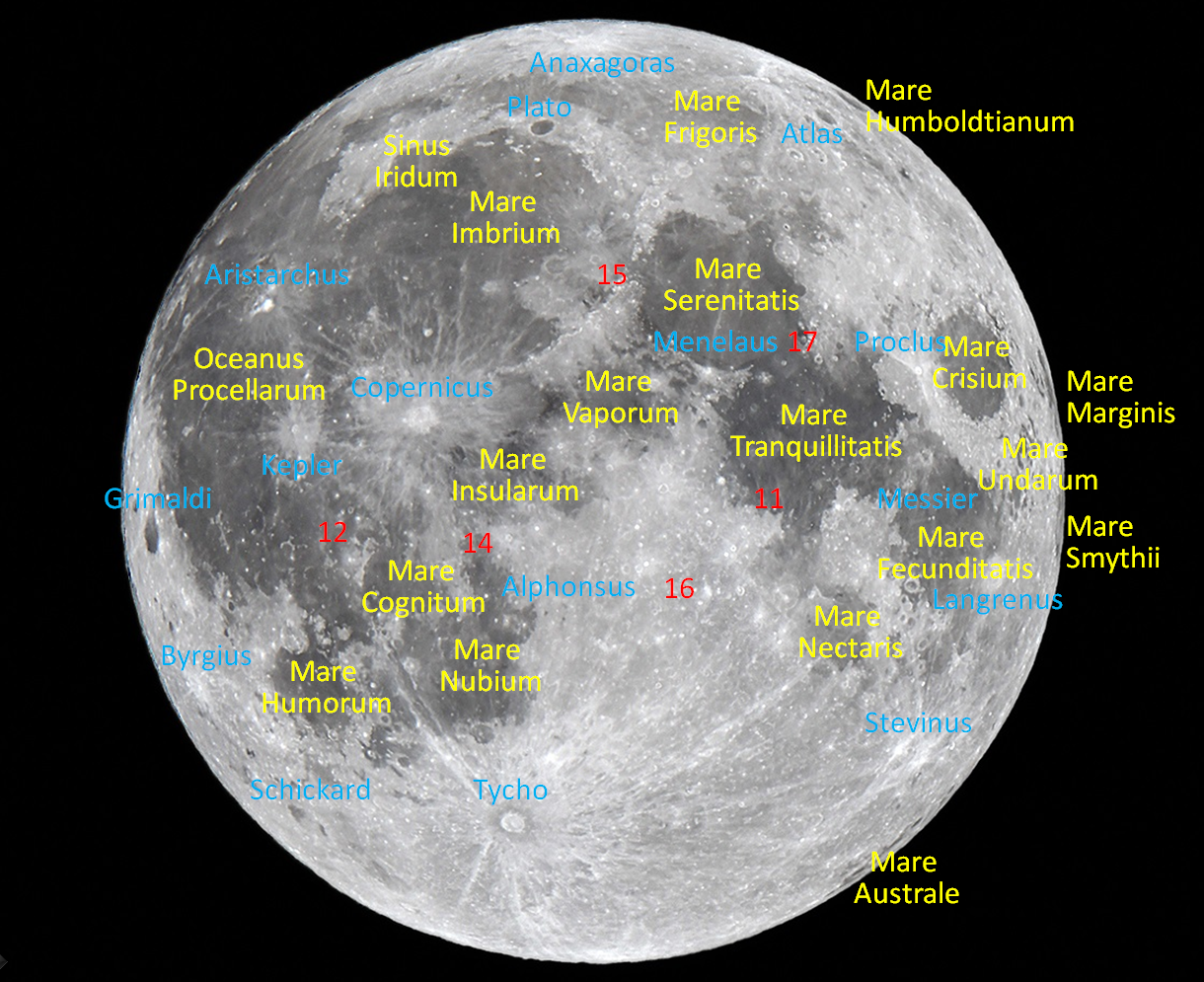
Prominent features on the moon for unaided eyes, binoculars, and backyard telescopes have been marked on this image by Michael Watson of Toronto. While none of the equipment is visible from Earth, the red numerals mark the Apollo landing sites.
Hello, Mid-winter Stargazers!
Here are your Astronomy Skylights for the week of February 18th, 2024 by Chris Vaughan. Feel free to pass this along to your friends and send me your comments, questions, and suggested topics. You can also follow me on Twitter as @astrogeoguy! Unless otherwise noted, all times are expressed in Eastern Time. To subscribe to these emails please click this MailChimp link.
If you’d like me to bring my Digital Starlab portable inflatable planetarium to your school or other daytime or evening event, or deliver a session online, contact me through AstroGeo.ca, and we’ll tour the Universe, or the Earth’s interior, together! My book with John A. Read entitled 110 Things to See With a Telescope is a guide to viewing the deep sky objects in the Messier List – for both beginners and seasoned astronomers. DM me to order a signed copy!
The moon will brighten evening skies worldwide this week as it waxes to the full snow moon on Saturday morning in the Americas. I outline our main theories of lunar formation to give you more to think on as you view our natural satellite. Meanwhile Jupiter and Uranus are in the west in evening, and Venus will kiss Mars in a very close pre-dawn conjunction. Read on for your Skylights!
More Daylight
For those of us living at latitudes near Toronto’s 44° the sun is rising more than a minute earlier and setting two minutes later per day – adding about 2.8 minutes of daylight with each passing day. We’ll soon be left waiting for the stars to appear after dusk – especially once daylight saving time begins!
Looking at Lunar Origins
The natural satellites orbiting the planets in our solar system, including Earth’s moon, are all terrestrial – having hard surfaces that one can land on or walk upon. That makes them places that humans can visit and potentially live on. Their relatively low mass gives them shallower “gravity wells” that make it easier to land on and lift off from them. Moreover, the tidal attraction between each planet and its moons has slowed the moons’ rotation, tidally locking them with the same side always facing their planet. (That’s why we only see one hemisphere of the moon from here on Earth.) With all that in mind, it might be easier for humans to explore Mars by digging a base into the interior of Mars’ moons Phobos or Deimos and operating robots and drones on the surface virtually, with minimal time delay!
Since this will be a big year for the moon – with a total solar eclipse happening on April 8 – plus the fact that evening skies this week will be dominated by the moon, let’s look at how luna may have come to grace our skies.
There are currently four major theories that best explain how the moon formed. The rotational fission theory suggests that the young, rapidly spinning and still molten Earth threw off a “droplet” of Earth-stuff. The co-accretion theory has the Earth and moon coalescing out of the sun’s primordial gas and dust belt at the same time – making a “double planet”. The passing moon could have been formed elsewhere and captured by Earth’s gravity, as we believe many of the smaller moons of Jupiter, Saturn, Uranus, and Neptune have been. Or, finally, the impact theory suggests that a Mars-sized body formed during the early days of the solar system slammed into the Earth in a glancing blow that stripped material off of the Earth’s crust.
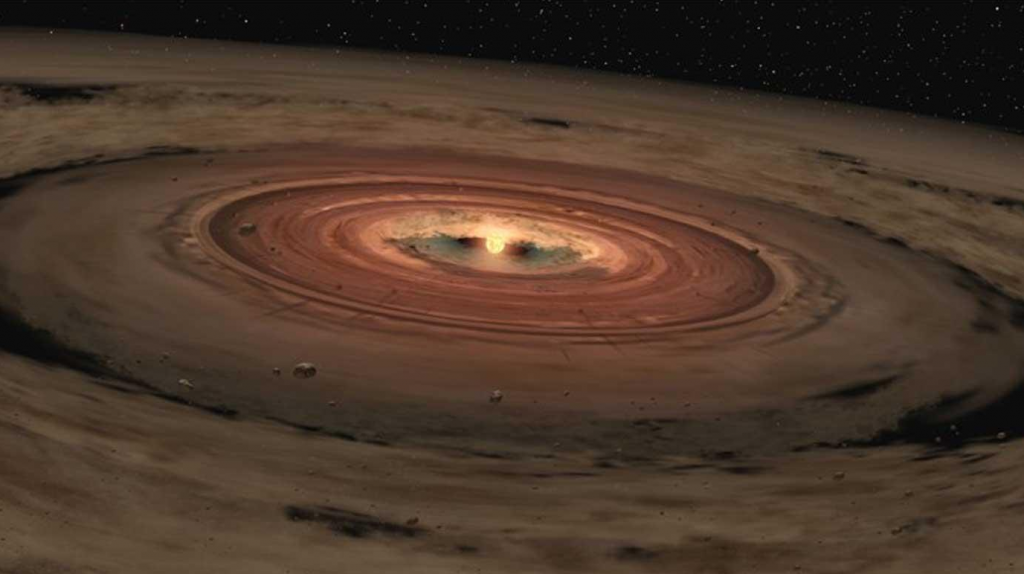
In order to decide which theory is true, scientists need to make observations that satisfy each moon formation model. Some of those measurements can be done from here. Others were carried out by the Apollo missions and the robotic landers and orbiters sent to the moon.
Here are the most important relevant pieces of evidence we have. The moon has more than 1% of Earth’s mass. That is much greater in relative terms than the other natural satellites in the solar system. The lunar bulk density (its total mass divided by its total volume) is 3.3 grams per cubic cm. That is lower than Earth’s average of 5.5 g/cm3, but is reasonably close to Earth’s crustal density of about 2.6 g/cm3. Earth’s total is boosted by our heavy iron core, which is relatively larger than the cores of Mercury, Venus, and Mars.
The speed and manner of the moon’s motion around Earth gives the duo a high angular momentum compared to the other planet-moon pairings. The moon is low in volatiles compared to Earth, meaning that is has reduced amounts of things we have lots of that boil off or melt at low temperatures, like potassium, sodium, lead, air, and water. The isotopes of the oxygen found in minerals from Earth and the moon are the same, but those amounts are much different from the isotopes found in meteorites. And, finally, at some point the lunar crust had to have melted to a depth of at least 200 km in order to give it an outer (or floating) plagioclase crust – the white crystalline surface rocks it has today.
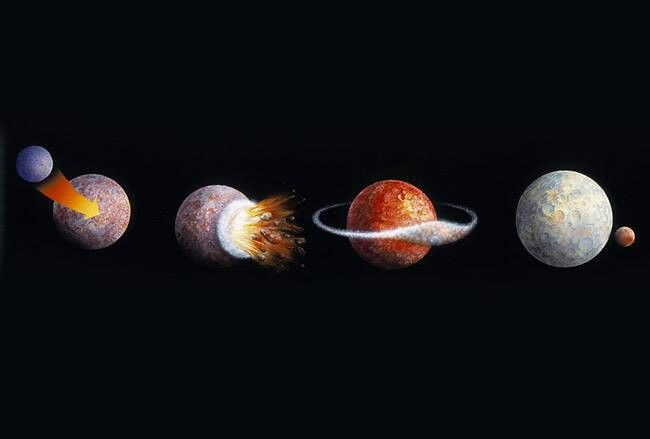
The fission model doesn’t explain the moon’s large size and large angular momentum, but it can explain the similar compositions between Earth’s crust and the moon. The co-accretion model explains the matching isotopes, but it doesn’t result in deep melting, the density difference, and the high angular momentum. The capture model contradicts the matching isotopes and the deep melting, but it doesn’t rule out the composition and density differences. At the moment, the impact model explains all the evidence rather well!
Our current thinking is that an object with about the mass of Mars, about 11% of Earth’s mass, formed when the solar system’s main planetary coalescing happened, about 4.6 billion years ago. The planet has been named Theia. In Greek mythology, Theia was one of the Titans and the mother of Selene, the goddess of the moon. Theia may have formed farther from the sun than Earth, enriching it in ices and contributing them to Earth’s water supply. It could also have formed at, or came to reside in, the gravitationally stable Lagrange points of Earth and the sun. At some point, the gravity of Jupiter or Venus, or both, could have put it on a collision course with the newly formed Earth.
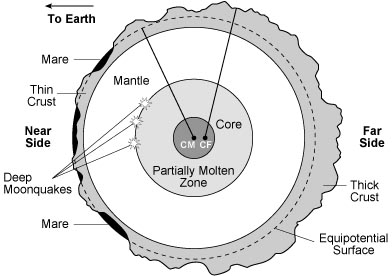
The impact had to be a glancing blow in order not to obliterate both Theia and Earth in a head-on collision. The cloud of debris stripped off of the Earth formed a ring that coalesced into the moon – in as soon as a few hours, by some studies! In any case, it happened rather quickly. Much of Theia would have become part of Earth, with the heaviest portions sinking inwards to boost Earth’s heavy core size.
Both the moon and the Earth would have been molten after such a violent event. The Earth’s very strong gravitational pull on the young moon would have slowed the moon’s spin very quickly, establishing much of the tidal locking we see today. Earth’s much slower cooling off time would also have baked the Earth-facing hemisphere of the moon, allowing it to remain warmer longer. The protoplanets and asteroids leftover from the solar system’s formation were pushed around by the gravity of the larger objects, causing them to slam into them during what scientist call the late heavy bombardment period between 4.1 and 3.8 billion years ago. The moon and other bodies still bear those scars, but Earth’s plate tectonics, and wind and water activity, has largely erased ours.
The giant basins carved into the moon’s surface were filled by dark basaltic rock that leaked from the interior of the moon later – between about 3.5 and 3 billion years ago. That flooding produced the dark maria, or basins, that we can see with our eyes and optical aids. By then, most of the interplanetary debris had been depleted, so the maria have been left largely unscathed since then. Craters like Copernicus and Kepler, and the numerous smaller craters that show up in telescopes, arose from impacts into the basins within the last billion years or so. Those younger craters look freshly made and sport ray systems of debris around them. The leftover heat from the cooling moon also allowed for some volcanism. A backyard telescope can see dark ash deposits spread across regions of the moon and dark stains around tiny caldera here and there.
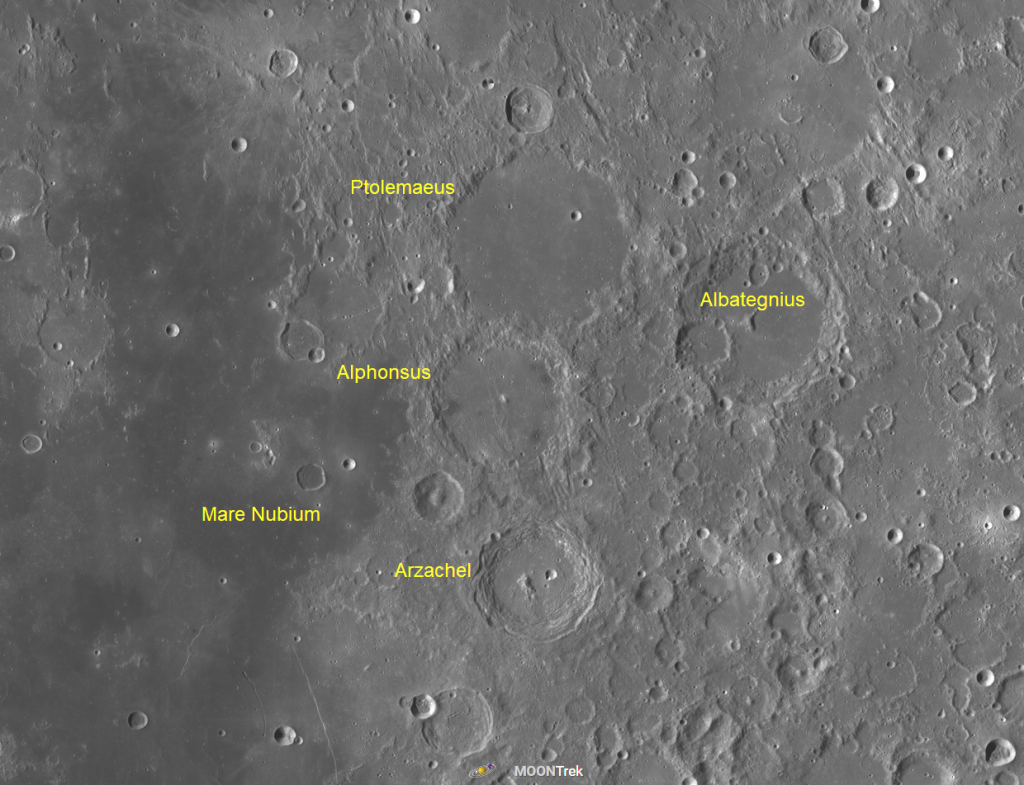
Take a good look at the moon this week and think on its interesting history!
The Moon
As I mentioned above the moon will shine in the evening sky worldwide this week. You’ll be able to spot its waxing gibbous shape in daylight during the afternoon for most of this week. It’ll rise about an hour later each day, though – leaving it a mostly night denizen by the weekend.
Once the stars come out to play at dusk tonight (Sunday), the bright Winter Hexagon and Winter Circle asterism will surround the moon. Bright, yellowish Capella in Auriga (the Charioteer) will shine about two fist diameters higher than the moon. The Gemini twins Castor & Pollux will shine about the same span to the moon’s left and reddish Aldebaran, the eye of Taurus (the Bull) will sparkle to the moon’s right. Reddish Betelgeuse below the moon will guide you down to Orion’s Belt and the bright bluish star Rigel at his feet. The dog stars Sirius and Procyon will catch your eye down to the lower left, while Jupiter, located off to the far right (or celestial west), will outshine all of those stars.
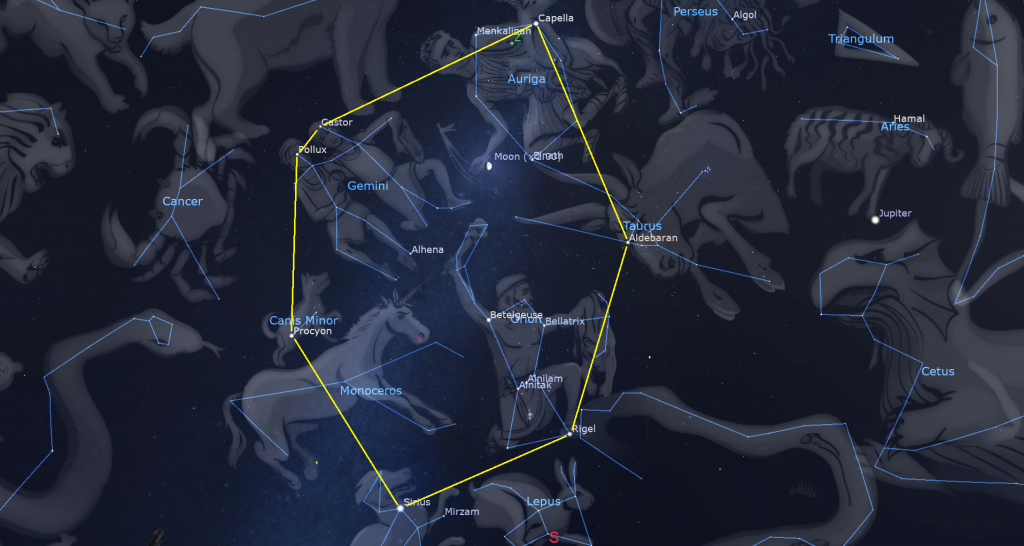
The ecliptic bisects the asterism, allowing the moon and planets to cross it frequently. The Milky Way passes vertically through the ring, but you won’t see its faint glow for until next week.
The moon’s orbital motion around Earth will carry it east through the giant shape. On Monday night, the moon will shift into Gemini. In the eastern sky on Tuesday evening, the bright, nearly full moon will shine a thumb’s width to the lower right (or ~1.7 degrees to the celestial south) of Pollux. Pollux’ slightly fainter twin, the double star Castor will sparkle above them. As the trio crosses the sky during the night, the moon will drift farther from Pollux, while the diurnal rotation of the sky will rotate Gemini’s stars to the moon’s right. Diurnal rotation causes objects to vary their tilt between the time they rise and set.

On Wednesday night the 95%-illuminated moon will pass a few finger widths above (or celestial north of) the large and densely populated star cluster in Cancer (the Crab) known as the Beehive, Praesepe the Manger, Messier 44, and NGC 2632. To better see the “bees”, wait until dark and then tuck the moon out of sight above your binoculars’ field of view. You can use Cancer’s medium-bright star Asellus Australis to help you find the Beehive – with or without the moon around. The star always sits a thumb’s width to the south of the cluster’s centre.
The moon will spend Thursday to Saturday crossing the stars of Leo (the Lion). By then it will be rising around 5 pm local time. Friday’s moon will shine a small distance to the left of Leo’s brightest star Regulus.
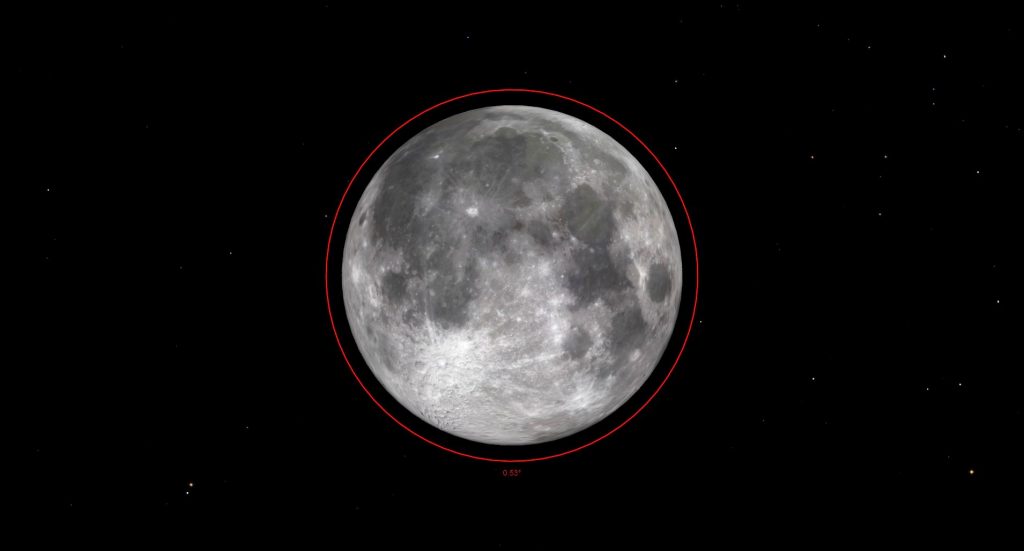
The February full moon will occur on Saturday, February 24 at 7:30 am EST, 4:30 am PST, or 12:30 Greenwich Mean Time. In the Americas the moon will appear almost full on both Friday and Saturday evening. The indigenous Anishnaabe (Ojibwe and Chippewa) people of the Great Lakes region call the February full moon Namebini-giizis “Sucker Fish Moon” or Mikwa-giizis, the “Bear Moon”. For them it signifies a time to discover how to see beyond reality and to communicate through energy rather than sound. The Algonquin call it Wapicuummilcum, the “Ice in River is Gone” moon. The Cree of North America call it Kisipisim, the “the Great Moon”, a time when the animals remain hidden away and traps are empty. For Europeans, it is known as the Snow Moon or Hunger Moon.
Because this full moon will occur only 26.5 hours before the moon’s apogee, its greatest distance from Earth this month, it will look about 7% smaller than average and shine a little less bright – making it the opposite of a supermoon and the smallest full moon of 2024.
The moon will end this week as an all-night-light shining above the stars of Virgo (the Maiden).
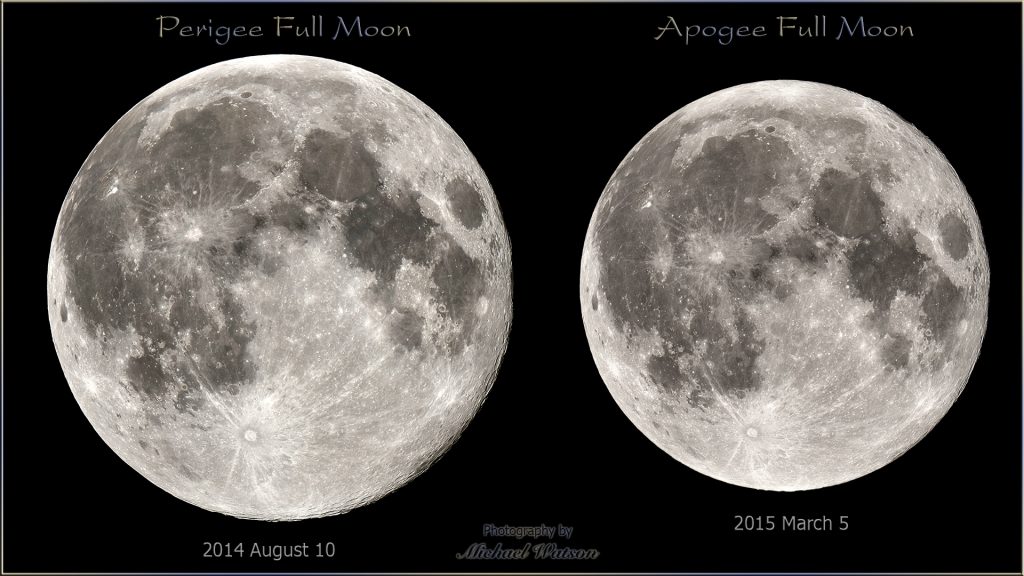
The Planets
Jupiter will dominate the evening sky worldwide only for about another month, after which its proximity to the setting sun will leave the planet swimming within the western twilight for a further few weeks. Since Jupiter has been approaching Uranus to its east, both planets will exit stage west in April. Other than occasional visits by Mercury, and pre-dawn twilit sightings of Mars and Saturn, the night sky will be without planets until Saturn returns in July.
For now, Jupiter’s brilliant dot will first appear high in the southwest as the sky begins to darken after sunset. Plan to make your telescope viewing of Jupiter as soon as you can see the planet. Bright planets can show more detail in a twilight sky. You’ll get great views of Jupiter in a telescope until about 10 pm local time. It will set before midnight. Jupiter will be surrounded by the stars of Aries (the Ram) on its right (or celestial north) and the palm’s-wide ring of stars forming the head of Cetus (the Whale) on its left.
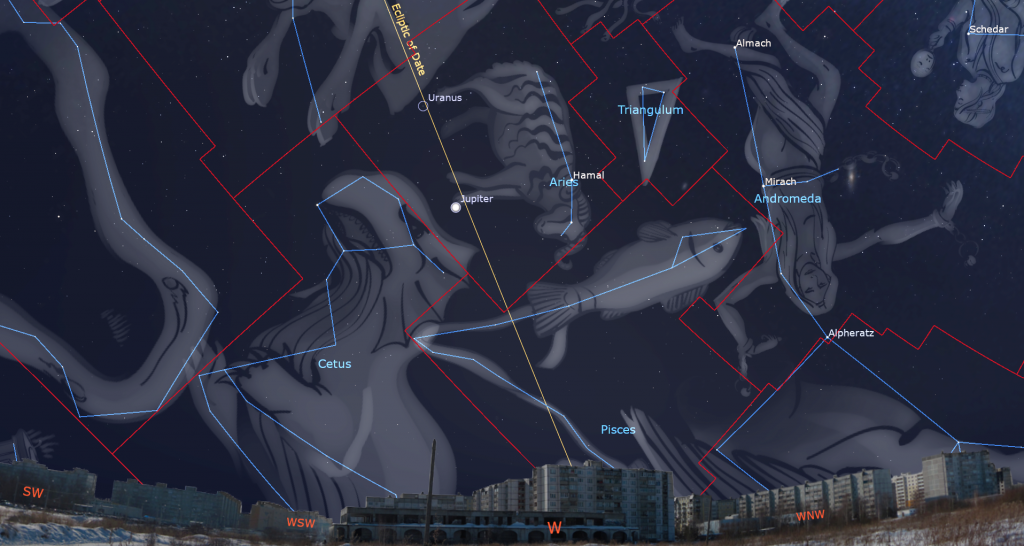
Any decent pair of binoculars can show you Jupiter’s four largest Galilean moons lined up on both sides of the planet. Named Io, Europa, Ganymede, and Callisto in order of their orbital distance from Jupiter, those moons complete orbits of the planet every 1.7, 3.6, 7.2, and 16.7 days, respectively. If you see fewer than four moons, then one or more of them is crossing in front of or behind Jupiter, or hiding in Jupiter’s dark shadow – or two of the moons are very close together or occulting one another.
A small telescope will reveal Jupiter’s dark belts and light zones, which are aligned parallel to its equator. While Jupiter sinks in the west, those lines will be tilted upright. With a better grade of optics, Jupiter’s Great Red Spot, a cyclonic storm that has raged for hundreds of years, is visible for several hours when it crosses the planet every 2nd or 3rd night. For observers in the Americas, the GRS will cross Jupiter’s disk in mid-evening Eastern Time on Monday, Wednesday and Saturday. The spot will appear late tonight (Sunday) with Ganymede’s black shadow, on Wednesday, Friday, and next Sunday night. The spot has been rather a pale pink in colour for some time now. If you have any coloured filters or nebula filters for your telescope, try enhancing the spot with them.
From time to time, the small, round, black shadows cast by Jupiter’s Galilean moons become visible in amateur telescopes when they cross (or transit) the planet’s disk. For those in the Americas, Ganymede’s large shadow will cross Jupiter’s southern polar region tonight, Sunday, February 18 from 9:35 to 11:05 pm EST (or 02:35 to 04:05 GMT on Thursday). Io’s small shadow will cross Jupiter on Thursday, February 22 from 4:52 to 6:57 pm EST (or 21:52 to 23:57 GMT, best seen in the Atlantic Time Zone. (These times may vary by a few minutes, and other time zones of the world will have their own crossings.)
Blue-green Uranus is located 55 minutes behind Jupiter on the ecliptic, in the eastern regions of Aries (the Ram). The magnitude 5.8 planet is normally quite easy to see in binoculars and backyard telescopes, but this week’s moon will make that harder. Look for Uranus about one fist diameter to Jupiter’s upper left (or 9.8° to its celestial ENE). The bright Pleiades star cluster will be a generous fist’s width above Uranus (or 11.5° to its celestial northeast). Jupiter and Uranus will creep closer together every night until they kiss in twilight on April 20.
The brilliant planet Venus will clear the rooftops in the southeast around 6:30 am local time this week, accompanied by far fainter Mars. One of 2024’s closest planetary conjunctions will occur on the mornings surrounding Thursday, February 22, when the brilliant planet Venus’ return sunward will carry it very closely on the upper left (or only 0.6 degrees to the celestial north) of far fainter Mars. You might spot both planets with your unaided eyes. Binoculars will capture the pair easily, too. They’ll be close enough together to share the view in a backyard telescope from Monday to Saturday, with Venus approaching Mars from the upper right before Thursday, and then sliding to Mars’ lower left afterward. Note that your telescope may flip and/or mirror that arrangement.) Skywatchers closer to the tropics will see Mars more easily.
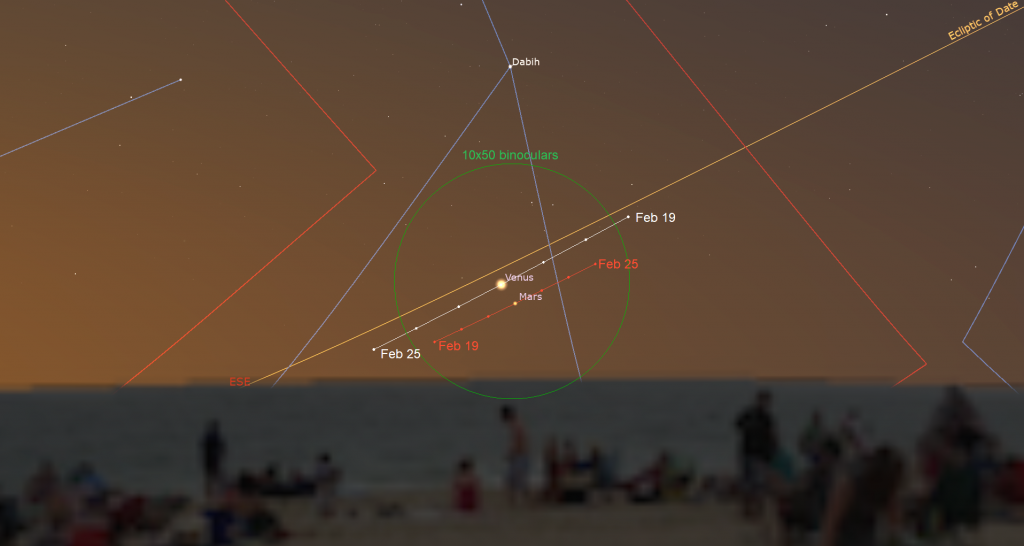
This week Venus will shift east through Capricornus (the Sea-Goat) by more than a palm’s width. Venus will soon be gone from view for a lengthy stretch. Mars will stick around all year and into 2025. Its travels will carry it close to other planets and some deep sky treasures while it gradually returns to the evening sky.
Public Astronomy-Themed Events
Every Monday evening, York University’s Allan I. Carswell Observatory runs an online star party – broadcasting views from four telescopes/cameras, answering viewer questions, and taking requests! Details are here. They host in-person viewing on the first clear Wednesday night each month. Other Wednesdays they stream views online via the observatory YouTube channel. Details are here.
At 7:30 pm on Wednesday, February 21, the RASC Toronto Centre will livestream their free monthly Speaker’s Night Meeting. The speaker will be Prof. Andrew Hopkins, Professor of Astronomy, School of Mathematical and Physical Sciences, Macquarie University, Australia. His topic will be The Evolutionary Map of the Universe. Check here for details and watch the presentation at https://www.youtube.com/rasctoronto/live.
On Sunday afternoon, February 25 from 12:30 to 1 pm EST, RASC Toronto astronomers will livestream views of the sun for the David Dunlap Observatory Sunday Sungazing program. During this family-friendly session, a DDO Astronomer will show filtered views of our closest star – the sun – and answer your questions! More information is here and the registration link is here.
Keep your eyes on the skies! I love getting questions and requests. Send me some!